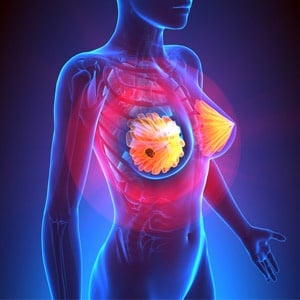
Summary
- Paget's disease of the nipple is a rare type of breast cancer.
- It usually appears only on one breast.
- It is characterised by burning, scaling and itchiness of the nipple.
- It can easily be mistaken for a rash.
- It is linked to underlying breast cancer.
Description
Paget’s disease of the nipple is a rare type of breast cancer, which occurs mainly in older women, and appears as a rash on the nipple.
The changes in the nipple usually indicate that there is an underlying cancer in the breast ducts. This is often just under the nipple and has extended into the nipple.
This sign of breast cancer may indicate a non-invasive area of ductal carcinoma in situ (DCIS).
In other cases, Paget’s disease of the nipple may indicate an invasive cancer in another part of the breast. Some women who come to the doctor with a nipple rash will have a lump in the breast, which can be found by physical examination or mammogram.
Paget's disease of the nipple should not be confused with Paget's Disease, which is a bone disorder.
Who gets it?
One to four percent of breast cancers involve Paget’s disease of the nipple.
The disease affects groups ranging from forty to eighty years of age, with an average age of sixty years.
Symptoms and signs
Most women notice this disease themselves, since it starts with:
- Persistent crustiness, scaling and redness of the nipple
- Possible itchiness or burning
- Possible oozing or bleeding from the nipple area
This disease may at first. look like eczema of the nipple Eczema should respond to simple treatment with corticosteroid creams. If a rash on the nipple does not disappear with such treatment, then Paget’s disease is suspected. In an older woman who goes to the doctor with a nipple rash, Paget’s disease should be considered without waiting to see if the rash responds to steroid creams.
Usually, only one nipple is affected, and the underlying nodules may surface, become crusted, exudative, very hard, itchy, ulcerative and can bleed. The Paget's growth is slow and may become painful.
Diagnosis
If Paget’s disease is suspected, then the next step is often a mammogram to see if there is any definite area of cancer within the breast. However, if nothing is found, this is no reason to assume that further cancer is not present.
A biopsy of the nipple tissue will provide a definite diagnosis. If a lump or other suspicious area of breast was found on mammogram, this area will also be biopsied.
Biopsy
The main test, which will help to check for evidence of cancer below the skin surface. A small piece of skin and underlying breast tissue is taken and sent to the laboratory to be examined under a microscope. The biopsy is usually done using a local anaesthetic, which numbs the area.
Imprint or scrape cytolopgy
Cells from the affected area are scraped or pressed into a slide and examined under a microscope.
Mammogram (breast x-ray)
Mammograms may be used to look for changes in the affected breast and to check the other breast.
Prevention
Although there is no known cause, the disease cannot be prevented. At best it could be detected at an early stage, which could guarantee proper treatment and recovery.
Treatment
Since Paget’s disease of the nipple is essentially a diagnosis of breast cancer per se, the treatment is the same as that for any other form of breast cancer, which has been diagnosed early enough for surgery.
The location of any cancer within the breast will determine the type of surgery which is preferred, however, mastectomy is usually indicated if Pagets disease is present.
If the cancer is far from the nipple, then a mastectomy may be needed to remove the breast lump and the entire nipple.
Drug therapy may be necessary after the mastectomy.
Outcome
Since Paget’s disease of the nipple is essentially a diagnosis of breast cancer per se, the outcome is the same as that for any other form of breast cancer, which has been diagnosed early enough for surgery.
Other similar conditions
Fungal infections of the nipple (e.g. thrush) and eczema
When to call a doctor
Seek medical attention the moment you notice any skin changes, especially around the breast.
Check monthly for lumps, sores or oozing from your breast and report any changes immediately to a physician.
Previously reviewed by Dr Jenny Edge, General Surgeon
Reviewed by Dr David Eedes, Oncologist, February 2011




 Publications
Publications
 Partners
Partners











